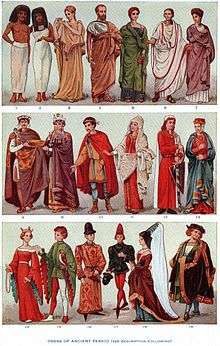Hose (clothing)
Hose are any of various styles of men's clothing for the legs and lower body, worn from the Middle Ages through the 17th century, when the style fell out of use in favour of breeches and stockings. (See also trousers.) The old plural form of "hose" was hosen. In German these terms (Hose, singular, and Hosen, plural) remained in use and are the generic terms for trousers today. The French equivalent was chausses.
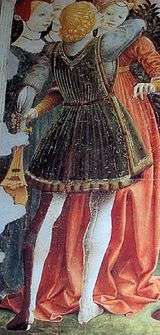
History
Early wool hose were fitted to the leg, and 15th century hose were often made particolored or mi-parti, having each leg a different colour, or even one leg made of two colors. These early hose were footed, in the manner of modern tights, and were open from the crotch to the leg. When very short doublets were in fashion, codpieces were added to cover the front opening.
By the 16th century, hose had separated into two garments: upper hose or breeches and nether hose or stockings.
From the mid-16th to early 17th centuries, a variety of styles of hose were in fashion. Popular styles included:
- Trunk hose or round hose, short padded hose. Very short trunk hose were worn over cannions, fitted hose that ended above the knee.
- Slops or galligaskins, loose hose reaching just below the knee.
- Trunk hose and slops could be paned or pansied, with strips of fabric (panes) over a full inner layer or lining. Pansied slop is a round hose characterized by the addition of a layer of panes, or strips of fabric running from the waistband to the leg band. These are commonly referred to as "pumpkin" pants.
- Pluderhosen, a Northern European form of pansied slops with a very full inner layer pulled out between the panes and hanging below the knee.[1] Originating in Germany, Pluderhosen soon spread to central and Eastern Europe.[2]
- Venetians, semi-fitted hose reaching just below the knee.
Gallery
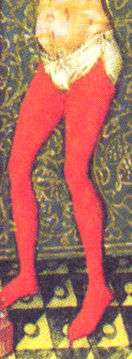 Hose or chausses worn with braies and tied to a belt, 1440
Hose or chausses worn with braies and tied to a belt, 1440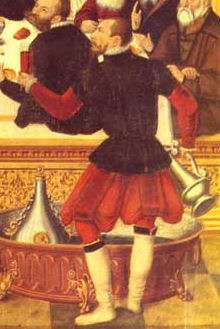 Servant wearing pluderhosen, 1565
Servant wearing pluderhosen, 1565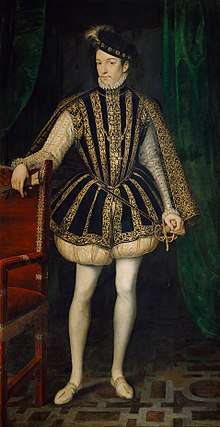 Charles IX of France wearing padded hose, 1566
Charles IX of France wearing padded hose, 1566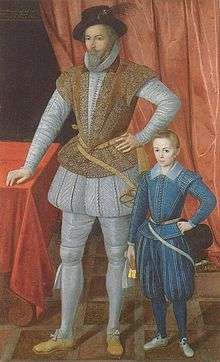 Sir Walter Raleigh in paned trunk hose and cannions, and his son in loose slops, 1602
Sir Walter Raleigh in paned trunk hose and cannions, and his son in loose slops, 1602- Sigismund III of Poland in Spanish-style hose, while one of the popular type of hose in Spain around that time were Polish-style hose, ca. 1620[3][4]
See also
- 1500–1550 in fashion
- 1550–1600 in fashion
References
Notes
- Arnold (1986), pp. 16–18.
- Kopalinski, Wladyslaw. "Słownik". Slownik-online. Archived from the original on 2 April 2015. Retrieved 28 May 2015.
- Marcin Latka. "Portrait of King Sigismund III Vasa of Poland". artinpl. Retrieved 2 August 2019.
- de Leguina, Enrique (1812). Glosario de voces de armería. F. Rodríguez. p. 194.
A la polaca. Las de rayas transversales.
Bibliography
- Arnold, Janet: Patterns of Fashion: the cut and construction of clothes for men and women 1560–1620, Macmillan 1985. Revised edition 1986. (ISBN 0-89676-083-9)
External links
- Hose in the Middle Ages and Renaissance 13th–16th century hose, from illustrations and museums

